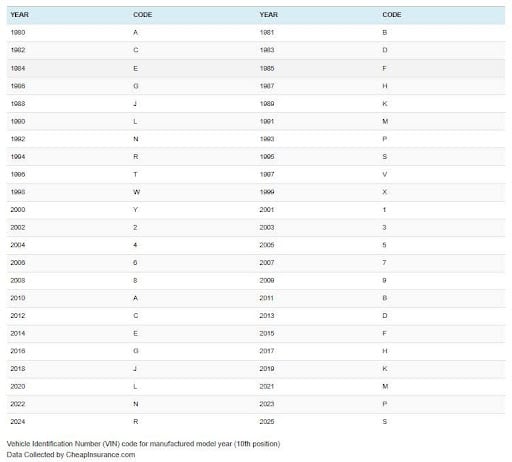
Does car color affect auto insurance?
This story was produced by CheapInsurance.com and reviewed and distributed by Stacker Media.
Does car color affect auto insurance?
You may have heard that red cars have the highest insurance costs. This is often stated as a fact, with the explanation that police officers view people with red cars as more reckless and likely to speed.
It is important to know that this is a misconception. Red cars cost the same to insure as any other color car and are not more expensive to insure. In fact, it is only in certain instances that you may expect your car insurance rates to increase as a result of the color of your car.
In this article, CheapInsurance.com will take a look at which color cars cost more to insure, as well as other factors that will influence your auto insurance rates.
Why Is It Believed That Car Color Affects Insurance Rates?
Why do 40% of Americans believe that a red car is more expensive to insure?
The answer could be that red cars tend to be more expensive to buy, which in turn means that a more expensive car will be more costly to insure.
Red, black, white, and blue cars tend to be the most expensive car colors to buy because they are in high demand with consumers.
Popular colors keep vehicle insurance prices from coming down, because dealerships don't need to negotiate prices for high in demand colors the way that they would need to do for less expensive models.
In a sense, the color of your car will impact your auto insurance rate. However, it is not the color of the paint job on your car that is the problem, but rather the value of your car that will influence your car insurance rate.
What Is the Most Popular Colored Car?
While you see some interesting car colors on the road, it turns out that most drivers prefer to blend in when it comes to the color of their car.
According to a survey done by Axalta Coating Systems, the most popular car colors in North America are:
- White: 29%
- Black: 19%
- Gray: 17%
- Silver: 11%
- Blue: 10%
- Red: 9%
- Brown: 2%
- Green: 1%
- Yellow/Gold: 1%
- Other: 1%
When Will the Color of Your Car Impact Car Insurance Rates?
As we've mentioned earlier, there are certain car colors that are more popular, and therefore in higher demand. Car dealerships tend to charge more for these car colors.
Apart from the actual value of your car and the amount that you paid for it, the only other factors that may increase your car insurance rate could be a custom paint job or vehicle wrap.
Modifying your car with a custom paint job or any other modifications such as new rims can look great, but you will need to report these to your car insurance company.
When it comes to auto insurance, your insurance company will expect that your car is in the same condition as when you bought it in its original form.
For this reason, if you have a custom paint job done or wrap your vehicle in special vinyl, you will need to report this to your car insurance company if you want these modifications to be covered after an accident.
Most insurance companies offer special insurance coverage for aftermarket modifications.
This coverage will extend your automobile insurance to include repairs to your customizations if they are damaged in an accident. This includes a custom paint job or wrap.
Other modifications that you will typically report to your car insurance company include:
- New wheels or rims.
- Headlights.
- Sound systems.
- Suspension or lift kits.
- Exhaust.
- Turbochargers.
What Factors Definitely Affect Auto Insurance Rates?
Now that you know that color doesn't automatically impact your car insurance rates, you may be wondering what factors you need to consider when asking for a new car insurance quote.
First of all, your insurer will ask for your vehicle identification number, or VIN.
Your VIN provides a description of your vehicle to your insurance company. Let's take a quick dive into what your insurance company will learn from your VIN.
World manufacturer identifier (WMI)
The first three positions in a VIN number show the world manufacturer identifier. The first position identifies which country the vehicle was made in.
- 1, 4 or 5 = United States.
- 2 = Canada.
- 3 = Mexico.
- J = Japan.
- K = Korea.
- S = England.
- W = Germany.
- Y = Sweden/Finland.
The second position identifies the company that made the car.
- A = Audi, Jaguar, or Mitsubishi.
- B = BMW or Dodge.
- C = Chrysler.
- D = Mercedes-Benz.
- F = Ford or Subaru.
- G = General Motors, Pontiac, or Saturn.
- H = Honda or Acura.
- J = Jeep.
- N = Nissan.
- R = Audi.
- T = Toyota or Lexus.
- V = Volkswagen VW or Volvo.
- 1 = Chevrolet.
- 4 = Buick.
- 6 = Cadillac.
The third position identifies the vehicle's type or manufacturing division.
Vehicle Descriptor Section (VDS)
Positions four to nine identify the vehicle descriptor section. The fourth, fifth, sixth, seventh, and eighth positions identify certain specifics.
These positions tell you the:
- Specific vehicle model.
- Specific engine type.
- Specific body style.
The ninth position is used to see if the VIN is invalid.

Vehicle Identifier Section (VIS)
VIS provides you with information such as when the vehicle was produced and the specific options or optional features that were added.
These numbers or letters will vary depending on your vehicle. The tenth position (number or letter) tells you the model year.
This standard applies to vehicles built in or after 1981. Before 1981, the VIN format was not standardized and was different for each car manufacturer.
To confirm the year in which your vehicle was manufactured, you can use the reference above.
VIN Model Year Codes
The last 7 positions of the VIN provide you with information about the vehicle the VIN is assigned to.
These details would be:
- The name of the assembly plant.
- Specific options on the vehicle.
- Production number.
Your VIN is located on the bottom right-hand side of your windshield and inside the driver door.
When it comes to your vehicle, the following factors will influence how much you pay for your auto coverage:
- Make of the car.
- Model.
- Engine size.
- Body type.
- Age of the vehicle.
- Vehicle value.
- Cost to repair.
Insurance companies will also look at non-car-related factors when calculating your car insurance premiums. In other words, they will look at you as the driver.
They will consider factors such as your:
Age
Younger drivers tend to pay more for car insurance coverage compared to older drivers, primarily because older drivers are seen to be more experienced on the roads.
Driving record
Drivers with a clean driving record pay less for auto insurance than those with multiple points or traffic violations to their name.
Years of driving experience
Depending on when you received your driver's license, the number of years you have been on the road will impact your car insurance premium. A new driver will pay more for car insurance.
Location
There are various factors when it comes to your location that will influence your car insurance rates. The safety of your neighborhood will be considered, as well as whether you live in a state where hail, floods, and other adverse weather conditions have the potential to damage your vehicle.
Credit score
If you are able to maintain a good credit score, you will be able to keep your car insurance premiums low. In some states insurers are allowed to use your credit score in insurance rating. This is because people with a good credit score are seen to be better, less risky drivers.
Type of coverage
There are various types of coverage that you can get, including liability coverage, comprehensive coverage, collision coverage, and full coverage. While the cheapest car insurance premium would be for liability coverage, you can select additional coverages depending on your needs.
Deductible
A deductible is the amount of money you need to pay toward a claim. For instance, if your damages cost $5,000 to repair and your deductible is $500, your insurance company will contribute $4,500 to the claim.
You can decide on the deductible you want to pay. A higher deductible will equal a lower car insurance premium.
The Bottom Line About Car Color and Car Insurance
At the end of the day, the color of your car is highly unlikely to increase or decrease your insurance costs. There are more important factors that your insurance company will typically consider when calculating your premiums.
If you want to save money on car insurance, don't worry about the color of your car. Rather look at your driving history, and the make and model of your car, as well as your coverage limits to help find cheaper auto insurance.



